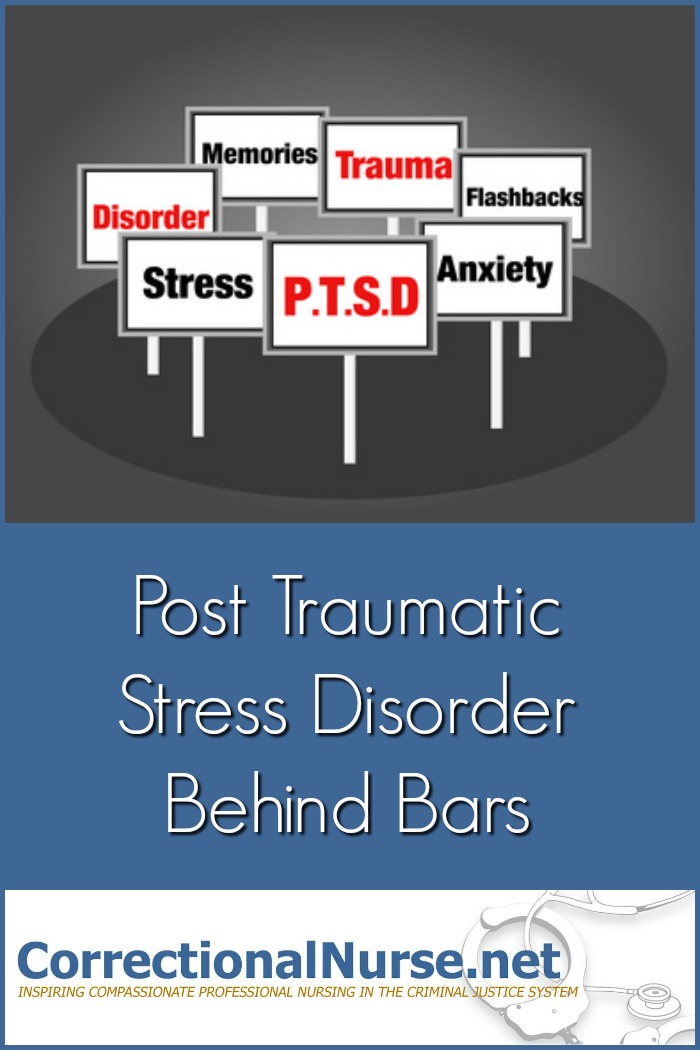 The past life experiences of many incarcerated patients lead to post traumatic stress disorder (PTSD). According to the National Institutes of Mental Health, PTSD develops after a terrifying event or when a person is regularly put in danger or in a deadly situation. Inmate patient histories frequently include physical or sexual abuse and many have been involved in violent crime. Incarcerated military veterans can also exhibit signs of PTSD. Imprisonment can intensify the PTSD experience as some facilities have an inmate culture of intimidation, coercion, and victimization.
The past life experiences of many incarcerated patients lead to post traumatic stress disorder (PTSD). According to the National Institutes of Mental Health, PTSD develops after a terrifying event or when a person is regularly put in danger or in a deadly situation. Inmate patient histories frequently include physical or sexual abuse and many have been involved in violent crime. Incarcerated military veterans can also exhibit signs of PTSD. Imprisonment can intensify the PTSD experience as some facilities have an inmate culture of intimidation, coercion, and victimization.
Survivor Response to Trauma
Individuals respond to trauma in various ways based on their own background, developmental phase and the type of trauma inflicted. Like the pain experience, a survivor’s response to trauma is unique. However, there are commonalities among these responses. Here are three main categories of symptoms related to post traumatic stress disorder (PTSD):
- Reexperiencing the event. Your patient may experience nightmares and flashbacks of a traumatic event. For example, a woman who had been sexually assaulted as a child may have difficulty sleeping as memories of the assault flood into her mind when she tries to relax.
- Avoidance. You patient may become anxious when confronted with objects or activities that can be associated with the trauma. For example, a stern command from an officer may trigger domestic violence memories. Severe manifestations of avoidance can lead to social isolation and even psychological dissociation.
- Hyperarrousal. Victims of trauma can also exhibit increased irritability and exaggerated responses to environmental danger signals. For example, the patient described above may run for the corner of the room screaming when given the command by the officer.
Emotional and Psychological Support Interventions
With these survivor responses in mind, you can provide emotional and psychological support for your patients who are dealing with PTSD. It can be challenging to balance objectivity and empathy when dealing with victims of violence.
- Establish rapport. A patient can pick up a caring attitude and interest by facial expression and body language. Eye contact and listening show concern and establish rapport without getting personal with the patient.
- Respect and patience. As you listen to the patient, actively attend to being respectful and patient. This provides emotional support.
- Help the patient express their feelings. Traumatized patients will have difficulty finding words to communicate their distress and the details of their experience. Fear, sadness, or rage is hard to describe when the feelings are present. Helping victims give words to their feelings can be very therapeutic. Don’t impose your own words on the experience, but, rather, help your patient find their own words.
Counseling and Crisis Intervention
A traumatized patient will, most likely, need professional support beyond what you can provide in a brief nursing encounter. Seek out other possible interventions available in your setting. Mental health services, group therapy, peer-to-peer support, or outside resources may be part of support services that can be provided for patients with severe PTSD.
Do you see signs of PTSD in your incarcerated patients? How do you handle it? Share your thoughts in the comments section of this post.
Photo Credit: © jacquimoo – Fotolia.com
Leave a Reply